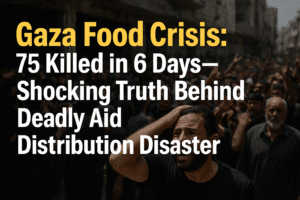Gaza Food Crisis: 75 Killed in 6 Days—Shocking Truth Behind Deadly Aid Distribution Disaster
Israeli forces killed three starving Palestinians waiting for food at a U.S.-Israeli aid point in Rafah on June 2nd, raising the death toll of aid seekers to at least 75 in just six days. Eyewitnesses describe Israeli troops opening fire directly on civilians, with many shot in the head or chest. This violence occurs within a controversial new aid system run by the U.S.-Israeli backed Gaza Humanitarian Foundation (GHF), which replaces established UN agencies. Major humanitarian groups condemn the model as “dehumanising, dangerous and severely ineffective” (MSF), warning it weaponizes aid and may constitute crimes against humanity. The GHF’s heavily guarded hubs corral desperate civilians, creating lethal bottlenecks where food becomes bait.
Meanwhile, Israel’s complete siege since March 2nd deliberately blocks all food, water, and medicine, using starvation as collective punishment. This systematic failure occurs against a backdrop of catastrophic loss: over 54,000 Palestinians killed since October, including disproportionate numbers of women, children, and aid workers. These preventable deaths at food lines represent a profound moral collapse and the predictable outcome of militarizing humanitarian relief.

Gaza Food Crisis: 75 Killed in 6 Days—Shocking Truth Behind Deadly Aid Distribution Disaster
The scene repeats with horrific regularity in Gaza: desperate civilians gather, hoping for food to sustain their families. Then, gunfire erupts. On Monday, June 2nd, Israeli forces killed three starving Palestinians waiting near a U.S.-Israeli backed aid distribution point in Rafah. This latest tragedy brings the death toll of Palestinians killed while seeking food aid to at least 75 in less than a week – a grim statistic etched in suffering and systemic failure.
The Queue That Became a Killing Field:
Eyewitness accounts paint a chilling picture. Marwa al-Naouq described the chaos near the Gaza Humanitarian Foundation (GHF) hub in Rafah: crowds surging forward for food, the sudden appearance of a quadcopter opening fire, followed by Israeli troops shooting directly into the crowd. American security forces reportedly added tear gas to the lethal mix. “Dozens were killed and injured as people ran in every direction, trying to escape,” she recounted to Middle East Eye.
The Rafah incident followed attacks just hours earlier where Israeli forces reportedly killed at least 35 Palestinians at two other U.S.-Israeli food distribution points. Gaza’s Health Ministry details a pattern of fatal injuries – gunshot wounds to heads and chests – indicating targeted, lethal force against civilians driven to desperation by starvation.
A “Dehumanising, Dangerous, and Ineffective” System:
The GHF, launched on May 27th, represents a controversial shift. Backed by the U.S. and Israel, it centralizes distribution to a few heavily guarded hubs, sidelining established UN agencies. While claiming to distribute “tens of thousands” of food boxes, aid organizations universally condemn the model.
Claire Manera, MSF’s Emergency Coordinator, states unequivocally: “This new system of aid delivery is dehumanising, dangerous and severely ineffective.” She links the preventable deaths directly to the system’s design, warning that “weaponising aid in this manner may constitute crimes against humanity.” MSF insists aid must be delivered by independent humanitarian organizations focused solely on safe and effective distribution.
Rob Williams, CEO of War Child Alliance, condemns the inherent violence of the model: “Corralling desperate families behind fences and placing aid under armed guard violates not only humanitarian principles but common decency.” He sees it as an “ugly system” using food as a tool for military and political objectives, disguised as humanitarianism.
Starvation as a Weapon, Suffering Beyond Numbers:
This crisis stems directly from Israel’s complete siege, intensified since March 2nd. All food, water, and medicine are barred, explicitly used as leverage to force Hamas into renegotiating a ceasefire. While Israel demands the release of captives, Hamas insists on a permanent ceasefire to prevent resumed violence.
The human cost is staggering:
- At least 54,000 Palestinians killed since October 2023 (Palestinian officials), representing nearly 3% of Gaza’s pre-war population – approximately 1 in 35 people.
- Over 28,000 women and girls killed.
- 1,400+ healthcare workers, 280+ UN staff (highest in UN history), 180+ journalists (highest recorded by CPJ).
- A Lancet study suggests fatalities are likely undercounted by 41%, estimating 59.1% of those killed are women, children, and the elderly
.
The Unseen Scars and the Path Forward:
Beyond the immediate horror lies the profound trauma: families mourning loved ones killed not in combat, but while seeking sustenance; children witnessing unimaginable violence in places meant for survival; the erosion of hope and dignity for an entire population.
This isn’t merely a series of tragic incidents; it’s the predictable outcome of a system designed without humanity at its core. As Claire Manera implores, “Humanitarian aid must be provided only by humanitarian organisations who have the competence and determination to do it safely and effectively.” The alternative – militarized food distribution points becoming scenes of massacre – is a devastating indictment of policy choices and a catastrophic failure to uphold the most basic principles of human decency in the face of engineered famine. The queues for food must not become queues for death.
You must be logged in to post a comment.